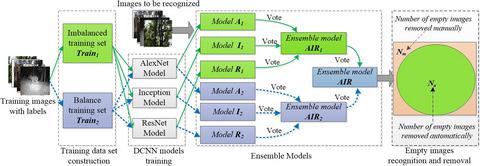当前位置:
X-MOL 学术
›
Ecol. Evol.
›
论文详情
Our official English website, www.x-mol.net, welcomes your
feedback! (Note: you will need to create a separate account there.)
An automatic method for removing empty camera trap images using ensemble learning
Ecology and Evolution ( IF 2.3 ) Pub Date : 2021-05-02 , DOI: 10.1002/ece3.7591 Deng-Qi Yang 1, 2, 3, 4 , Kun Tan 2, 3 , Zhi-Pang Huang 2, 3 , Xiao-Wei Li 1, 4 , Ben-Hui Chen 1, 4 , Guo-Peng Ren 2, 3 , Wen Xiao 2, 3
Ecology and Evolution ( IF 2.3 ) Pub Date : 2021-05-02 , DOI: 10.1002/ece3.7591 Deng-Qi Yang 1, 2, 3, 4 , Kun Tan 2, 3 , Zhi-Pang Huang 2, 3 , Xiao-Wei Li 1, 4 , Ben-Hui Chen 1, 4 , Guo-Peng Ren 2, 3 , Wen Xiao 2, 3
Affiliation

|
Camera traps often produce massive images, and empty images that do not contain animals are usually overwhelming. Deep learning is a machine-learning algorithm and widely used to identify empty camera trap images automatically. Existing methods with high accuracy are based on millions of training samples (images) and require a lot of time and personnel costs to label the training samples manually. Reducing the number of training samples can save the cost of manually labeling images. However, the deep learning models based on a small dataset produce a large omission error of animal images that many animal images tend to be identified as empty images, which may lead to loss of the opportunities of discovering and observing species. Therefore, it is still a challenge to build the DCNN model with small errors on a small dataset. Using deep convolutional neural networks and a small-size dataset, we proposed an ensemble learning approach based on conservative strategies to identify and remove empty images automatically. Furthermore, we proposed three automatic identifying schemes of empty images for users who accept different omission errors of animal images. Our experimental results showed that these three schemes automatically identified and removed 50.78%, 58.48%, and 77.51% of the empty images in the dataset when the omission errors were 0.70%, 1.13%, and 2.54%, respectively. The analysis showed that using our scheme to automatically identify empty images did not omit species information. It only slightly changed the frequency of species occurrence. When only a small dataset was available, our approach provided an alternative to users to automatically identify and remove empty images, which can significantly reduce the time and personnel costs required to manually remove empty images. The cost savings were comparable to the percentage of empty images removed by models.
中文翻译:

一种使用集成学习自动去除空相机陷阱图像的方法
陷阱相机通常会产生大量图像,而不含动物的空图像通常会令人难以承受。深度学习是一种机器学习算法,广泛用于自动识别空相机陷阱图像。现有的高精度方法基于数百万个训练样本(图像),需要大量的时间和人员成本来手动标记训练样本。减少训练样本的数量可以节省手动标记图像的成本。然而,基于小数据集的深度学习模型会产生较大的动物图像遗漏误差,许多动物图像往往被识别为空图像,这可能导致失去发现和观察物种的机会。因此,在小数据集上建立误差较小的 DCNN 模型仍然是一个挑战。使用深度卷积神经网络和小规模数据集,我们提出了一种基于保守策略的集成学习方法来自动识别和删除空图像。此外,我们为接受不同动物图像遗漏错误的用户提出了三种空图像自动识别方案。我们的实验结果表明,当遗漏误差为0.70%、1.13%和2.54%时,这三种方案分别自动识别并删除了数据集中50.78%、58.48%和77.51%的空图像。分析表明,使用我们的方案自动识别空图像并没有遗漏物种信息。它仅略微改变了物种出现的频率。 当只有小数据集可用时,我们的方法为用户提供了自动识别和删除空图像的替代方案,这可以显着减少手动删除空图像所需的时间和人员成本。节省的成本与模型删除的空图像的百分比相当。
更新日期:2021-06-22
中文翻译:

一种使用集成学习自动去除空相机陷阱图像的方法
陷阱相机通常会产生大量图像,而不含动物的空图像通常会令人难以承受。深度学习是一种机器学习算法,广泛用于自动识别空相机陷阱图像。现有的高精度方法基于数百万个训练样本(图像),需要大量的时间和人员成本来手动标记训练样本。减少训练样本的数量可以节省手动标记图像的成本。然而,基于小数据集的深度学习模型会产生较大的动物图像遗漏误差,许多动物图像往往被识别为空图像,这可能导致失去发现和观察物种的机会。因此,在小数据集上建立误差较小的 DCNN 模型仍然是一个挑战。使用深度卷积神经网络和小规模数据集,我们提出了一种基于保守策略的集成学习方法来自动识别和删除空图像。此外,我们为接受不同动物图像遗漏错误的用户提出了三种空图像自动识别方案。我们的实验结果表明,当遗漏误差为0.70%、1.13%和2.54%时,这三种方案分别自动识别并删除了数据集中50.78%、58.48%和77.51%的空图像。分析表明,使用我们的方案自动识别空图像并没有遗漏物种信息。它仅略微改变了物种出现的频率。 当只有小数据集可用时,我们的方法为用户提供了自动识别和删除空图像的替代方案,这可以显着减少手动删除空图像所需的时间和人员成本。节省的成本与模型删除的空图像的百分比相当。











































 京公网安备 11010802027423号
京公网安备 11010802027423号